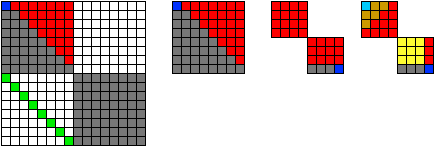
In the D4-D5-E6 and HyperDiamond Feynman Checkerboard Models:
0. Below the Planck length, or above the Planck energy,
the HyperDiamond structure of spacetime breaks down.
1. Either discrete or continuous structures can be used
above Planck length. Discrete are used at Planck length.
2. Either compact or noncompact structures can be used.
3. Antisymmetric representations of the D4 Weyl group give
the Lie algebra Spin(0,8) and its Clifford algebra.
4. 28 generators of Spin(0,8) are gauge bosons.
5. 8-dim vector representation space is spacetime.
6. 8-dim +/-halfspinor row left and right ideals give Dirac operator.
7. 8-dim +halfspinor column left ideal gives fermion spinor particles.
8. 8-dim -halfspinor column right ideal gives antiparticles.
9. 1-dim scalar representation gives Higgs scalar.
11. classical Lagrangian in 8-dim with first generation fermions
is constructed from global E6 symmetry and
octonion structure of the Spin(0,8) representations.
12. Second and third generation fermions
come from global E7 and E8 symmetry and produce
CP symmetry violation.
13. 8-dim E8 HyperDiamond lattice spacetime splits into
an associative 4-dim HyperDiamond lattice
physical spacetime
plus
a coassociative 4-dim HyperDiamond lattice
internal symmetry space.
14. quantum 4-dim Lagrangian is defined by Many-Worlds
sum over Feynman Checkerboard path histories.
15. Dimensional reduction converts Spin(0,8) gauge bosons into
gauge bosons for the standard model (with Higgs) plus gravity.
16. Symmetric representations of Weyl groups give
Casimir operators, Cohomology, and BRST transformations.
17. quantum theory can be done using BRST transformations.
The breakdown of the 28 Spin(0,8) gauge bosons can be seen by looking at reduction of the Clifford Algebra Cl(0,8) of Spin(0,8) to get SU(3)xSU(2)xU(1) plus Higgs and Gravity
Click on this Picture to read about the Spin(0,8) Clifford Algebra:

Here is
Kobayshi-Maskawa parameters come from quark constituent masses and lepton masses.
d s b
u 0.975 0.222 0.00249 - 0.00388 i
c -0.222 0.974 0.0423
-0.000161 i -0.0000365 i
t 0.00698 -0.0418 0.999
-0.00378 i -0.001086 i
The Kobayashi-Maskawa parameters were calculated from the following
tree-level lepton masses and quark constituent masses:
Me = 0.5110 MeV (assumed);
Me-neutrino = Mmu-neutrino = Mtau-neutrino = 0;
Md = Mu = 312.8 MeV (constituent quark mass);
Ms = 625 MeV (constituent quark mass);
Mc = 2.09 GeV (constituent quark mass);
Mb = 5.63 GeV (constituent quark mass);
Mt = 129.5155 (rounded to 130) GeV (constituent quark mass).
according to the following formulas:
phase angle d13 = 1 radian
sin(a) = [Me+3Mu+3Md] /Sqrt( [Me^2+3Mu^2+3Md^2] + [Mmu^2+3Mc^2+3Ms^2] )
sin(b) = [Me+3Mu+3Md] /Sqrt( [Me^2+3Mu^2+3Md^2] + [Mtau^2+3Mt^2+3Mb^2] )
sin(g') = [Mmu+3Mc+3Ms] /Sqrt( [Mmu^2+3Mc^2+3Ms^2] + [Mtau^2+3Mt^2+3Mb^2] )
sin(g) = sin(g') Sqrt( [Mmu+3Mc+3Ms] / [Me+3Mu+3Md] )
As calculated in the HyperDiamond Feynman Checkerboard model:
tree-level weak boson masses are
Mw+ = Mw- = 80.326 GeV and Mz0 = 91.862 GeV;
Higgs field Vacuum Expectation Value = 252.514 GeV;
electromagnetic fine structure constant = 1/137.03608;
weak force Gfermi = (Gweak)(Mproton)^2 = 1.045 x 10^(-5);
color force strength = 0.6286 (at 0.245 GeV);
color force strength = 0.167 (at 5.3 GeV);
color force strength = 0.121 (at 34 GeV); and
color force strength = 0.106 (at 91 GeV)
Color force strength calculation used Perturbative QCD.
If Nonperturbative QCD is taken into account, then
color force strength = 0.123 (at 91 GeV)
Pions and Protons are 4-D versions of: Sine-Gordon Breathers made up of quark-antiquark pairs; and Nontopological Solitons similar to tHooft-Polyakov monopoles made up of rgb quark triples.
In this model, the quark constituent masses are fundamental.
The Planck mass is the mass of a condensate of pions at one point.
Some thoughts about cohomology, quadrics, and dimensional reduction.
......